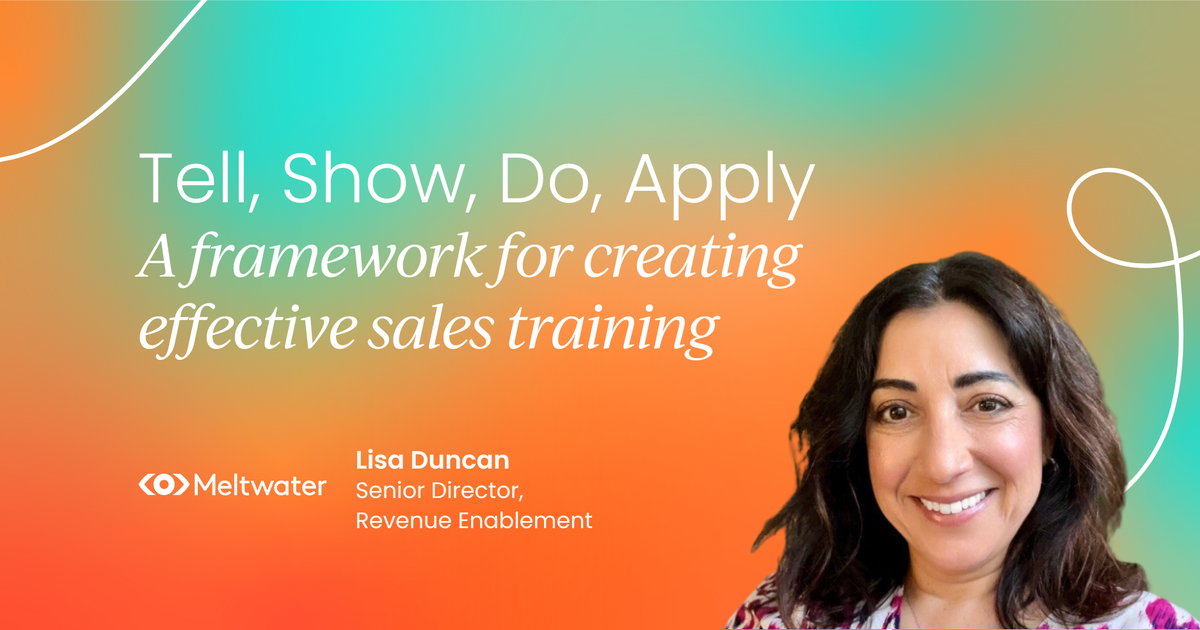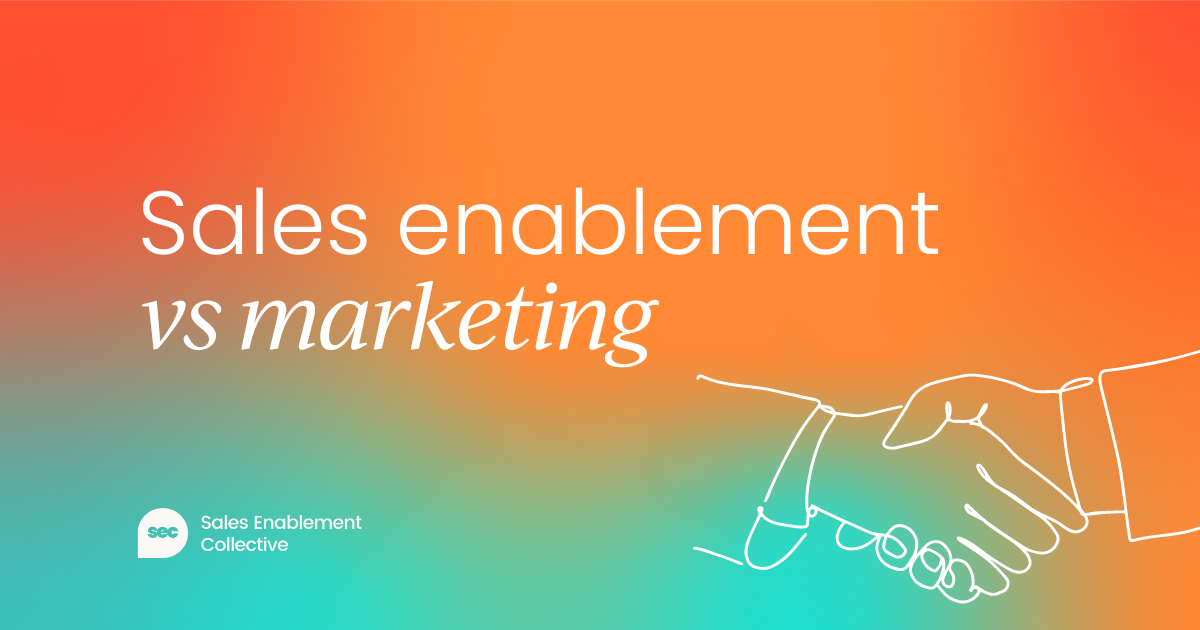As revenue enablement becomes more popular in the business world, many teams are looking to empower their marketing teams with marketing enablement.
But what exactly is marketing enablement?
A simple marketing enablement definition is: A role focused on empowering the marketing team in an organization by providing them with the tools and resources needed to succeed. (Keep reading for more detail.)
This article acts as your guide to the marketing enablement function, including:
- What marketing enablement is
- The benefits
- 5 best practices
- How to build a training program
- Tools and technology
- Metrics and KPIs
What is marketing enablement?
Marketing enablement is a support function that provides the marketing team with the resources and training they need to be effective in their role. In particular, this function focuses on improving marketing teams' efficiency and effectiveness using technology and data analytics.
This function is also responsible for training and coaching marketers and marketing managers to ensure they’re up to date with industry best practices, as well as having a strong understanding of the products your company sells.
Other responsibilities of a marketing enablement team include:
- Analyzing content performance and usage
- Optimizing the marketing tech stack
- Streamlining marketing and content creation processes
- Aligning marketing and sales teams
- Tracking marketing performance
- Onboarding the marketing team
Marketing enablement vs sales enablement
Marketing enablement is often confused with sales enablement, as both functions serve similar purposes: supporting and training teams. They can even share the goal of aligning sales and marketing.
But these functions have one fundamental difference: the stakeholders they serve.
While marketing enablement professionals focus on empowering marketing teams and ensuring their success, sales enablement pros focus on helping sales reps close deals.
Both are important functions that contribute to the buyer journey and help to increase revenue growth using content, training, technology, and data.
In many organizations, these functions will be aligned into one revenue enablement team that supports all the revenue-generating functions including sales, marketing, and customer success.
This can help to increase the efficiency of enablement initiatives, especially in smaller organizations, as resources can be repurposed to meet each teams’ needs.
Marketing enablement vs marketing operations
Marketing operations is another support team for marketers, focusing on optimizing the tech stack, streamlining processes, and gathering marketing data.
There is quite a bit of overlap between marketing enablement and operations roles. So, many organizations will choose to combine these functions or will utilize revenue enablement (see above) and revenue operations teams working in tandem.
If your organization has both a marketing enablement and a marketing operations team, it’s important to create a charter defining who’ll be responsible for each specific area.
For example: Your enablement team may solely focus on training, coaching, and marketing resources, while your ops team focuses on tech management, data analysis, and process improvement. And you may decide to share process documentation projects.
Benefits of marketing enablement
Now we’ve covered what marketing enablement is, let’s dive into the benefits the function can bring to your organization.
Sales and marketing alignment
Marketing enablement teams seek to ensure sales and marketing teams are on the same page, to increase the marketing team’s impact and productivity.
Misaligned teams lead to inefficiencies as the content produced by marketing likely won’t align with what sellers need. This means marketing wastes time creating content that’ll gather (metaphorical) dust in a database, in turn, making it harder for sales to find useful resources.
By fostering cross-functional collaboration, the marketing team can focus on creating content that sales teams (and customers) will actually use and benefit from.
Personalized buyer experiences
Personalization is a must-have in marketing, but it can be time-consuming and challenging to get right.
Increased training and efficiency allow your marketing team to spend more time researching your persona, and creating personalized communications and experiences for your customers.
Dedicated buyer enablement and buyer enablement content, meanwhile, helps warm prospects and earn their trust before they even speak to a sales rep.
Improved lead generation
Marketing enablement improves lead generation through increased alignment between sales and marketing – making it easier to pass qualified leads over to the sales team.
Enablement also ensures marketing teams have the technology and knowledge needed to run strong lead-generation campaigns.
Content ROI
When it comes to content creation, marketing enablement teams analyze content usage data to determine the ROI of the marketing team’s content.
This allows teams to review pieces of content:
- Sales reps are using
- Buyers are looking at
- Are driving sales
- Aren’t being used (and are a waste of time)
With an increased understanding of their target audience and sales team’s needs, marketers can create more effective content tailored to their audience’s preferences.
Increased productivity
When marketing teams are empowered with the right training, data, and tools they can be more efficient in their roles and increase productivity.
Enablement teams help by streamlining processes and the tech stack while creating effective training programs to keep marketers at the top of their game.
Fast growth and increased profitability
Overall, a marketing enablement team leads to more effective marketing initiatives, contributing to increased pipeline growth, a faster sales cycle, and increased profitability.
5 marketing enablement best practices
Set goals
The first step in building a successful marketing enablement strategy is to outline your goals and objectives. What do you want to achieve by empowering your marketing team?
Ensure you align these goals with wider business objectives and other departments' plans. Speak to sales and marketing leaders to understand how they can collaborate and align to create results.
It’s also key to define a timeframe for the project and specific KPIs to track your progress.
Utilize data
It’s important to have all the data you need to make effective decisions easily accessible. This means aligning data in one place, such as a customer relationship management (CRM) system, and creating reporting dashboards for your marketing peers to utilize.
Pulling out data on marketing effectiveness, content usage, and conversion rates will help to refine your marketing enablement strategy, and focus your efforts in the most impactful areas.
For example, your team might be generating lots of leads, but they aren’t a great ICP fit. So, you might run a session educating your marketing team on the company’s ICP, their pain points, and what they’re looking for in a solution.
You can even include data and insights from the sales and customer success teams to fully explain this. But without looking at the CRM data, you likely wouldn’t have spotted that trend.
Create SOPs
Documenting standard operating procedures (SOPs) for your marketing team can help them to be more efficient in their work.
Not only do SOPs ensure the entire team is doing something in a similar way, they also act as sources of knowledge for those doing something for the first time (or after a while).
For example, if your team is changing email providers, they’ll need training on how to approach this new system. You may host a training session on this only to realize the team is still confused and has questions.
To resolve this, you can create a document outlining the processes step by step, and include the answers to common questions. That way marketers can refer to this every time they create an email, until they’re comfortable with the new process.
This is also useful for onboarding new hires, as they can also refer to the SOPs when doing something for the first time.
Organize content effectively
Organization is crucial to successful marketing enablement.
Whether it's your SOPs or any other resource you’ve created to assist the marketing team, they won’t use it if they can’t find it.
That’s why it’s important to organize these resources in a way that makes them easy to find and access when your team needs them. Otherwise, they may decide to ask the team or simply wing it.
This solution could be as simple as a Google Drive or Notion board hosting well-organized and labeled documents, or you could take it a step further and use a content management system.
Align with sales enablement
Enablement teams often struggle with a lack of time and resources, which is why it’s key to work with your sales enablement peers to ensure you aren’t duplicating work.
By aligning your marketing enablement and sales enablement strategies, you can cover more ground and foster collaboration.
For example, when a new product is set to launch you could work together to create training for the marketing and sales teams, as most of the information they require will be similar.
Once the bulk of the materials are created, each enablement function can tailor it to marketing and sales respectively.
Creating a marketing training program
When creating a training program for your marketing team it’s important to follow these four steps.
1. Discover skills and knowledge gaps
Talk to marketing managers to uncover the areas where the team may need some more training and support. This may be an area that’s underperforming, something new to the team, or something the manager regularly supports with.
You may also consider speaking with some of the marketers individually to discover where they feel they’d like to improve.
2. Design a training program
Once you understand the topics to cover in your program, it’s time to plan how you’ll deliver these to the team.
This includes:
- Prioritizing topics by most urgent
- Scheduling training sessions
- Designing supporting content and follow-ups
- Making the sessions interactive
- Selecting external courses to include
3. Tailor program to individuals
Once you’ve created a training program for your entire team, you can start to tailor the training protocols for individuals.
This could be as simple as adjusting the program for each level of seniority in your team, or as complex as providing each marketer their own program.
It’s important to balance the level of personalization with the resources you have available to deliver the program. It can be tempting to personalize every detail, but if you can’t fulfill each element your program won’t be effective.
4. Gather feedback and iterate
After each training session and at the end of each program, you should collect feedback from the marketing team to understand how effective they found it.
Based on the feedback you can tailor your next program to the needs and learning style of the team. Remember to do this regularly as preferences can change over time.
Tools and technology for marketing enablement
Marketing enablement professionals rely on technology to effectively empower marketing teams. Some tools they utilize include:
- CRM
- Content management systems
- Learning management systems
- Sales enablement platforms (don’t be confused by the name – sales enablement tools can also be tailored to marketing enablement teams)
- Email marketing tools
- Google Analytics
Marketing enablement metrics and KPIs
Measuring the success of a marketing enablement program can be challenging, as your programs only indirectly affect campaign success. So, your team shouldn’t focus too heavily on these success metrics.
That being said, it’s still important to check on these indicators to ensure your marketing team is getting more effective over time. This is especially true after running particular training programs – if after a few months the marketers you support are still struggling to hit their KPIs you may need to review your training content.
To track your marketing team’s performance consider looking at:
- Customer acquisition cost (CAC)
- Customer lifetime value (CLV)
- Lead conversion rate
- Engagement rate
- Landing page conversion rate
Where your programs really make a difference is in helping the team become more productive. But this is tricky to measure since this doesn’t always mean more marketing activity.
Sometimes simply gathering feedback after your training sessions is the best way to tell if they were successful. Some questions to ask include:
- Do you feel more confident doing [X] after this session?
- How effective was this training session?
- Would you recommend this session to your colleagues?
Looking for more content?


Sales enablement insider
Thank you for subscribing
Level up your sales enablement career & network with sales enablement experts
An email has been successfully sent to confirm your subscription.
 Follow us on LinkedIn
Follow us on LinkedIn


.png)


























